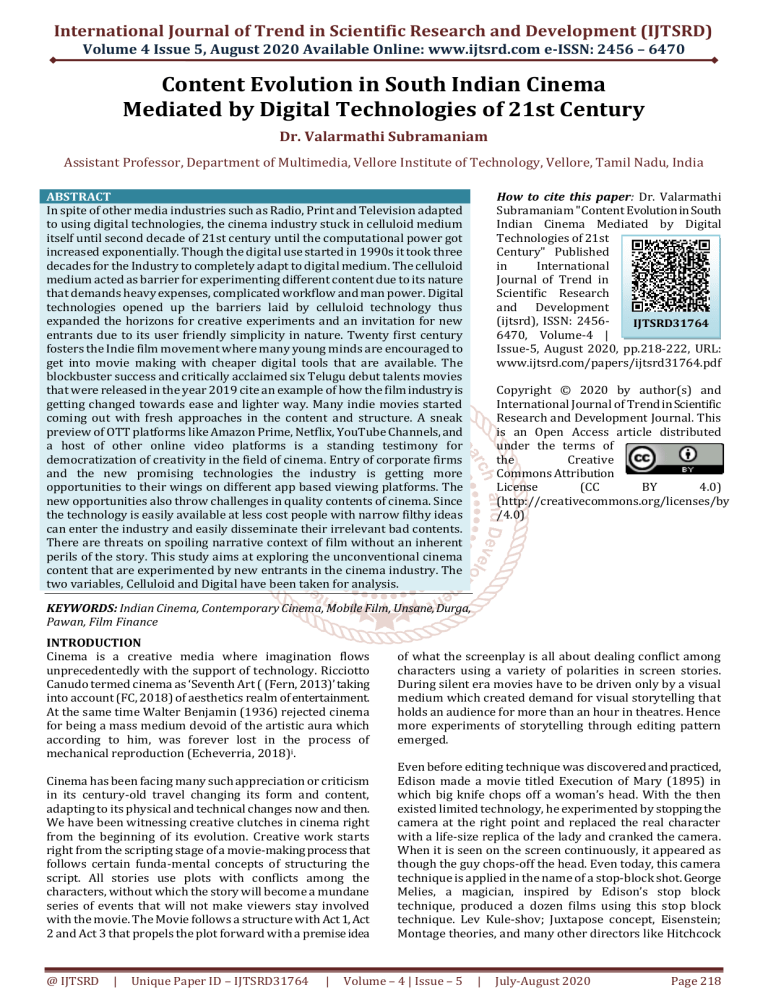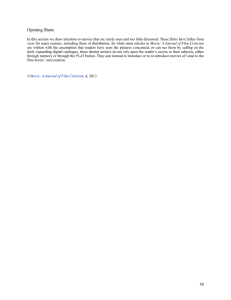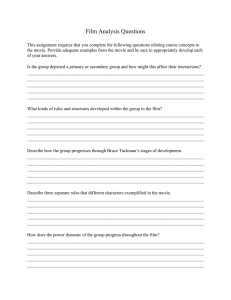
International Journal of Trend in Scientific Research and Development (IJTSRD)
Volume 4 Issue 5, August 2020 Available Online: www.ijtsrd.com e-ISSN: 2456 – 6470
Content Evolution in South Indian Cinema
Mediated by Digital Technologies of 21st Century
Dr. Valarmathi Subramaniam
Assistant Professor, Department of Multimedia, Vellore Institute of Technology, Vellore, Tamil Nadu, India
ABSTRACT
In spite of other media industries such as Radio, Print and Television adapted
to using digital technologies, the cinema industry stuck in celluloid medium
itself until second decade of 21st century until the computational power got
increased exponentially. Though the digital use started in 1990s it took three
decades for the Industry to completely adapt to digital medium. The celluloid
medium acted as barrier for experimenting different content due to its nature
that demands heavy expenses, complicated workflow and man power. Digital
technologies opened up the barriers laid by celluloid technology thus
expanded the horizons for creative experiments and an invitation for new
entrants due to its user friendly simplicity in nature. Twenty first century
fosters the Indie film movement where many young minds are encouraged to
get into movie making with cheaper digital tools that are available. The
blockbuster success and critically acclaimed six Telugu debut talents movies
that were released in the year 2019 cite an example of how the film industry is
getting changed towards ease and lighter way. Many indie movies started
coming out with fresh approaches in the content and structure. A sneak
preview of OTT platforms like Amazon Prime, Netflix, YouTube Channels, and
a host of other online video platforms is a standing testimony for
democratization of creativity in the field of cinema. Entry of corporate firms
and the new promising technologies the industry is getting more
opportunities to their wings on different app based viewing platforms. The
new opportunities also throw challenges in quality contents of cinema. Since
the technology is easily available at less cost people with narrow filthy ideas
can enter the industry and easily disseminate their irrelevant bad contents.
There are threats on spoiling narrative context of film without an inherent
perils of the story. This study aims at exploring the unconventional cinema
content that are experimented by new entrants in the cinema industry. The
two variables, Celluloid and Digital have been taken for analysis.
How to cite this paper: Dr. Valarmathi
Subramaniam "Content Evolution in South
Indian Cinema Mediated by Digital
Technologies of 21st
Century" Published
in
International
Journal of Trend in
Scientific Research
and Development
(ijtsrd), ISSN: 2456IJTSRD31764
6470, Volume-4 |
Issue-5, August 2020, pp.218-222, URL:
www.ijtsrd.com/papers/ijtsrd31764.pdf
Copyright © 2020 by author(s) and
International Journal of Trend in Scientific
Research and Development Journal. This
is an Open Access article distributed
under the terms of
the
Creative
Commons Attribution
License
(CC
BY
4.0)
(http://creativecommons.org/licenses/by
/4.0)
KEYWORDS: Indian Cinema, Contemporary Cinema, Mobile Film, Unsane, Durga,
Pawan, Film Finance
INTRODUCTION
Cinema is a creative media where imagination flows
unprecedentedly with the support of technology. Ricciotto
Canudo termed cinema as ‘Seventh Art ( (Fern, 2013)’ taking
into account (FC, 2018) of aesthetics realm of entertainment.
At the same time Walter Benjamin (1936) rejected cinema
for being a mass medium devoid of the artistic aura which
according to him, was forever lost in the process of
mechanical reproduction (Echeverria, 2018)i.
Cinema has been facing many such appreciation or criticism
in its century-old travel changing its form and content,
adapting to its physical and technical changes now and then.
We have been witnessing creative clutches in cinema right
from the beginning of its evolution. Creative work starts
right from the scripting stage of a movie-making process that
follows certain funda-mental concepts of structuring the
script. All stories use plots with conflicts among the
characters, without which the story will become a mundane
series of events that will not make viewers stay involved
with the movie. The Movie follows a structure with Act 1, Act
2 and Act 3 that propels the plot forward with a premise idea
@ IJTSRD
|
Unique Paper ID – IJTSRD31764
|
of what the screenplay is all about dealing conflict among
characters using a variety of polarities in screen stories.
During silent era movies have to be driven only by a visual
medium which created demand for visual storytelling that
holds an audience for more than an hour in theatres. Hence
more experiments of storytelling through editing pattern
emerged.
Even before editing technique was discovered and practiced,
Edison made a movie titled Execution of Mary (1895) in
which big knife chops off a woman’s head. With the then
existed limited technology, he experimented by stopping the
camera at the right point and replaced the real character
with a life-size replica of the lady and cranked the camera.
When it is seen on the screen continuously, it appeared as
though the guy chops-off the head. Even today, this camera
technique is applied in the name of a stop-block shot. George
Melies, a magician, inspired by Edison’s stop block
technique, produced a dozen films using this stop block
technique. Lev Kule-shov; Juxtapose concept, Eisenstein;
Montage theories, and many other directors like Hitchcock
Volume – 4 | Issue – 5
|
July-August 2020
Page 218
International Journal of Trend in Scientific Research and Development (IJTSRD) @ www.ijtsrd.com eISSN: 2456-6470
and others contributed several ideas of presenting the story
in a compelling visual narration style. Following the
invention of the talkie films in the year 1927, dialogues
complemented the function of visual that lessened the
burden of conveying the audience with what they intended
to say. Talkie films had an overarching function of relieving
the audiences through humorous dialogues in addition to the
portrayal of life like characters.
Content Evolution in Celluloid Cinema
Filmmaking always comprises of a unique blend of creativity
and application of technology. This synergy creates a new
realm of a creative transformation. This creative
transformation always goes to the next level, whenever new
instances of media technology occur. When the talkie films
ar-rived, it transformed the cinema in its native form and its
original narrative structure. Hitchcock contributed creative
editing techniques. The introduction of surround sound
brought a three-dimensional, realistic experience of space in
cinema theaters. Now the new media technology
developments bring mixed genre approach towards cinema
not only in content but also in its form.
At the early stage of new media technologies, a group of
informal filmmakers from Den-mark proclaimed the term
DOGME-The Vow of Chastity: a manifesto meant for informal
filmmaking (Gyenge, 2009), with a specific set of rules.
Gradually, this manifesto started finding followers in Europe
and other countries. Some amateur filmmakers in western
countries started exploring new media technologies by
substituting video cameras as a low-budget alternative for
the celluloid film cameras. Later, the distinctive visual
qualities of videos were explored for aesthetic storytelling
aspects. Though the narrative language of a movie remains
the same, the video texture helped in building up a distinct
cultural resonance that uses its juxtaposition of casual and
manipulated contrast genre and style. The advent of digital
technologies along with exponential growth of internet
facilities and broadband connectivity has unimaginable
impact on creative com-munity especially in their behavior
of consumption of entertainment contents.
The simultaneous growth of new media technologies and the
creative community of informal filmmakers resulted in
shifting away from conventional filmmaking practices. The
first effect is the freedom of experimenting at no cost in the
digital platform. The second effect is, since the digital
platform is readily available, inexperienced people started
making movies with little knowledge they have. The third
effect is, digital filmmaking gives scope for the new
filmmakers to make errors and mistakes. At times these
mistakes were accepted as a new trend in creativity. The
movie “Requiem for a dream” is one such example for
breaking the conventional filmmaking concepts. In editing
simultaneous close-up of two characters are used in splitscreen, following a converging line of action in real time. The
use of multiple-image effect in recent films experimenting
non-narrative story structure and sometimes exploring
visual textures has become a trend.
Content Evolution in 21st Century Fostered by
Technology Inventions
The new media era enables the imagination wings of a
contemporary scriptwriter to reach any destination that he
wishes, by altering the whole gamut of conventional
@ IJTSRD
|
Unique Paper ID – IJTSRD31764
|
storytelling methods. Also, the new media technologies have
brought in some essential modern tools for scriptwriters like
this draft screenwriting software, has a "collabo" function
that allows screenwriters in different locations to co-write
screenplays. Such new media technologies have the potential
to open up new dimensions in the scriptwriting process and
make moviemaking easier and more mobiles at all levels.
Digital technologies embolden the scriptwriters to
experiment by varying the presentation of a protagonist and
antagonist with different confrontation and resolution levels.
An ultimate change in conventional storytelling has been
confronted in recent years by the young new directors. The
movie “Vikram Vetha” directed by young couples; Pushkar
and Gayatri confronted both pro-tagonist and antagonist
changing from one to another by way of bringing who
decides who is right and wrong. In reality, all human being
makes mistakes, and no one is perfect. This concept is
reflected in the movie with an open ending to be decided by
the audience on who is right.
India's recently released big-budget blockbuster movies like
“Enthiran” “Bajirao Mastani” and “Bahubali” had set the
trends for the ultimate use of graphics. A list of shoestring
budget movies to high budget movies, which strive to engage
an audience equally witnesses the new me-dia technologies
era ushers in yet another new wave in the cinema industry.
KenDancyger states that there is going to be three significant
forms of cinema in the digital age (Dancyger, 2007).
“High-end features that push the technologies and
budget to create, smoothly ren-dered fantasies. These
features will allow the making of even more constructed
worlds at the content level, although the visual styles
that communicate these worlds will remain
conservative.
Mainstream features that depend on standardized highend, digital production technology and ultimately
widespread digital projection. These video films will
replace features as we know them, but there is little that
can be done creatively in this style that cannot be done
on film, and for such productions, the savings that digital
video might bring are a minimal element in the budget.
Independent features made in the digital video. These
independent features can be divided into those that
might have been shot on film, but for financial reasons
are not, and those that are conceived from the ground up
as digital features, and whose writing and design are
constructed around the particular aesthetic of digital
video”.
It is very well evident that the entire world produces these
three primary forms of a film. When analyzing movies
released in recent years, one could draw the link to what Ken
Dancyger states in his book Alternative Scriptwriting:
Successfully Breaking the Rules. High-end technologies push
the creativity to an unimaginable level of fantasy. The Indian
film industry is also no exception to Ken Dancyger’s theory.
Enthiran (2010) Ra One (2011), Bahubali (2015), 24 (2016)
are a few examples of such high-end technology driven
movies influenced by the new media digital platform. The
second form of cinema, Main Stream features that continues
with the usual type of storytelling but use the new media
technologies for widespread digital projection to maximize
Volume – 4 | Issue – 5
|
July-August 2020
Page 219
International Journal of Trend in Scientific Research and Development (IJTSRD) @ www.ijtsrd.com eISSN: 2456-6470
revenues for instance, Kabali (2016) which was released in
5,000 theatres simultaneously, recorded a massive collection
of several hundred crores, within short span of 10 days of its
release worldwide. The last category of independent small
budget films that are conceived and structured around a
particular aesthetic form supported by the digital platform.
For example, Vazhakku En 18/9 (2012), Lucia (2013), Aruvi
(2016) are some examples of content-oriented films that
were supported by digital technology within the financial
limitations of filmmakers.
Though budget wise movies differ, genre-wise Indian movies
follow a mixed pattern to attract all sectors of audiences.
Some audiences enjoy a particular genre. For example, teens
tend to slide on for gunfights, deployment of weaponry,
expertise in horsemanship, and survival skill in what is
necessarily a primitive wilderness in the case of older
people, melodrama where rela-tionships, their evolution,
and their outcome play central attraction. Hence movies are
made with multiple mixes of a genre considering all sectors
of audiences to keep them engaged in the plot so that they
stay relaxed and entertained. The ease of access enabled by
the new media technologies for movies to reach different
parts of the world demands resurgence in a genre and
presentation style against civilization rather than material
goals. The digital cinema is taking an international
dimension in which the stakes of human drama grow
increasingly dangerous. The digital era has taken non-linear
interconnected story approach with less conventional plot
and with the intensity of the individual scene rather than
from the organization of a progressive scene. The digital medium has not changed the stories but has just moved to
another frontier.
It is an interesting scenario, how the new media technologies
influenced the creative deci-sions and approach of a
filmmaker towards filmmaking by a comparative study of
two contempo-rary filmmakers hailing from a same
demographic area and industry; the two Stevens of Hollywood who is revolutionizing the form of cinema from their
perspective. Steven Spielberg, who is fantasizing the cinema
by using a high-end computer, generated images to narrate
Figure8. 2.0 Movie Poster, Source: Timesnow
@ IJTSRD
|
Unique Paper ID – IJTSRD31764
|
his story. Steven Soderbergh, who is simplifying the form of
cinema through his simple yet catchier films. The contrasting
impulse of these two directors and their approach to
narrative strategies have opened up two distinct digital
cinema genres. Steven Soderbergh released the movie titled
Unsane on 23rd March 2018, till then it was secretly kept
under wraps until he announced its release at Sundance film
festival. He stated in an interview at Sundance Film Festival
on 26th Jan 2018 that he shot this movie entirely using iphone with no conventional kind of filmmaking equipment
(Brody, 2018). Soderbergh attempted the model of
Fingerprint Release, a self-financed movie Logan Lucky
(2017) screened in over 3,000 screens, moving beyond
studio arena and emerging as a new chapter in filmmaking
aspect. For debut directors, the new media digital
technologies give immense op-portunities to try low-budget
scripts with more confidence and thereby showcase their
work to the audiences easily than it was during the celluloid
period. The hype, the glamour, the star attraction is getting
reduced in recent times. One such movie that hit the silver
screen breaking the conven-tional form of cinema and
breaking the barriers of opinion leaders is the mega-hit
movie titled ‘Aruvi (2017)’ directed by Arun Prabu
Purushothaman as his debut film. While sharing his experience, he said, none of the producers came forward to
produce the movie. The digital technology has made the
movie possible; within the limited resources he could
manage to complete the movie. The movie was made in an
entirely new form in an unprecedented fashion. Every nook
and corner of Tamilnadu talks about this movie, and it is the
audience who had taken up the movie to the height of
success. This movie is an excellent example for audience
expectation of social content themes and not just fantasy hip
hops by well-known heroes. While sharing the experience,
the director recalls how difficult is the movie market
scenario for debut films that have no established names in its
credits. He explains how he managed to release the movie
taking the festival route for familiarizing the movie to the
specific audience. Then it took almost a year to get it
released in commercial movie theaters (Chakraborthy,
2017).
Figure 9. Unsane Movie Poster Source: IMDB Website
Volume – 4 | Issue – 5
|
July-August 2020
Page 220
International Journal of Trend in Scientific Research and Development (IJTSRD) @ www.ijtsrd.com eISSN: 2456-6470
Figure10. Aruvi Movie Poster, Source: Indian Express News
Kannada film director Pawan Kumar produced Lucia (2013).
Without popular character or plot development, the sensual
acts linking urban and rural environments, the graphics
quality of the present and dream world he is in, are the most
tangible elements of this movie. The narrative elements did
not emerge in isolation but are instead storytelling tropes
traced back to a highly varied modernist legacy and, these
intertext complex assemblages are more befitting the label
'postmodern digital cinema' (Service, 2019). Lucia is a
critically acclaimed movie for its radical approach in
storytelling and touched a milestone in theater collection
(Bhumika, 2013). The PVR ‘Director's-Rare’ banner released
the movie. Because of digital technology he was able to make
such brilliant movie narrated in a non-linear manner with
the parallel editing of reality and hallucination shots in black
and white.
On sharing his experience, He insists that the way digital
technology used for making movies and the way it is used for
other purposes are entirely different. Filmmakers must learn
the nuances of using digital technology for filmmaking so
that they achieve the quality of a celluloid cinema. He feels
that the digital technology suppressed the quality of
storytelling and authenticity of cinema as art due to readily
available tools to budding filmmakers who start making
movies with their superficial knowledge. He feels that with
the digital technology, filmmakers often have no respect for
what they are doing, just because the technology is easily
available they end up re-shooting again and again. He feels
that the celluloid film demanded certain discipline in the
entire process of filmmaking. Whereas, the digital technology
opened the way for leniency, which affects the complete
perspective of filmmaking. Pawan concludes that young
filmmakers should look the digital medium for making a
good movie and not take it for granted because it is readily
available (Chaudhury, 2013).
Sanal Kumar Sasidharan who is seen as a ray of hope for the
indie film makers. After the successful accomplishment in
Malayalam film industry with five feature films, he strongly
be-lieves in constant adaptation to new forms of cinema
that’s wary from conventional three-act struc-ture
@ IJTSRD
|
Unique Paper ID – IJTSRD31764
|
(Srivatsan, 2020). He mainly focuses on bridging the gap
between real and screen form. One of his film S Durga, has
faced many obstacles for getting released in the theater
mainly due to the content of the movie. In spite of its
recognize in festival circuits, he could not make it to get
screened in theaters due to resistance by religious people
towards the content of the movie. Finally with the help of
promotional campaign kicked off by veteran film maker
Adoor Gopalakrishnan, through street plays and mobile
cinema vehicle, the film got released in few theaters under
audience demand (FC, 2018).
Conclusion
It is very well evident from the digital era filmmakers like
Arun Purushothaman and Pawan Kumar that the new
filmmakers stand at the intersection of the lure and blur
where we could see the outlines of new art forms with the
shattered grammar of cinema a tenuous and elu-sive
century-old language. Though the distinctive, conflicting
content ushered by young film makers faces resistance and
disinclination of acceptance by few members of the society,
the con-stant efforts by these young filmmakers pushes the
boundaries of cinema to next level. Thus the twenty first
century cinema satisfies the expectation of the new
millennium audience by enhancing the undefined stylistic
and narrative techniques in filmmaking. There is no doubt
that the new media digital technology has transformed the
mode of perception and awareness of the new generation
filmmakers.
Bibliography
[1] Bhumika. (2013, 8 09). Feature-Metroplus. Retrieved
from The Hindu:
[2] https://www.thehindu.com/features/metroplus/ilove-lucia/article5003478.ece
[3] Brody, R. (2018, 3 27). Culture. Retrieved from
Newyorker:
https://www.newyorker.com/culture/richardbrody/steven-soderberghs-inspired-iphoneexperiment-in-unsane
Volume – 4 | Issue – 5
|
July-August 2020
Page 221
International Journal of Trend in Scientific Research and Development (IJTSRD) @ www.ijtsrd.com eISSN: 2456-6470
[4] Chakraborthy, S. (2017, 12 11). Movies-Features.
Retrieved
from
Silvers
Screen
India:
https://silverscreenindia.com/movies/features/arunprabu-purushothaman-on-his-debut-film-aruvi-thejourney-has-been-a-rollercoaster-yet-fun/
[5] Chaudhury, B. (2013, 07 26). Movies. Retrieved from
Roobla: https://roobla.com/movies/26022/interviewwith-pawan-kumar-lucia/
[6] Dancyger, K. a. (2007). Alternative Script
Writing:Succesfully Breaking the Rules (4 ed.).
Newyork: Elsevier Inc. Focal Press.
features/s-durga-timeline-sanal-kumar-sasidharancbfc/
[9] Fern, E. (2013, 07 08). Cinema has been called the
seventh art. Retrieved from The News:
http://www.ngnews.ca/community/cinema-has-beencalled-the-seventh-art-66123
[10] Gyenge, Z. (2009, 1 1). Illusions of Reality and Fiction
or the Desired Reality of Fiction. Film and Media
Studies, pp. 69-79.
[7] Echeverria, D. &. (2018). Symbiotic CinemaConfluences between film and other media. 24th
SERCIA Conference, 17-21.
[11] Service, E. N. (2019, 07 23). Entertainment-Kannada.
Retrieved
from
New
Indian
Express:
https://www.newindianexpress.com/entertainment/k
annada/2019/jul/23/pawan-kumars-ticket-tobollywood-2007925.html
[8] FC, T. (2018, 4 5). A Timeline of S Durga's Rocky
Journey from Its First Screening to Release. Retrieved
from
Film
companion:
https://www.filmcompanion.in/features/bollywood-
[12] Srivatsan. (2020, 2 11). The Malayalam Filmmaker
chats about Chola. Retrieved from The Hindu:
https://www.thehindu.com/entertainment/movies/sa
nal-kumar-sasidharan-interview/article30781967.ece
@ IJTSRD
|
Unique Paper ID – IJTSRD31764
|
Volume – 4 | Issue – 5
|
July-August 2020
Page 222






